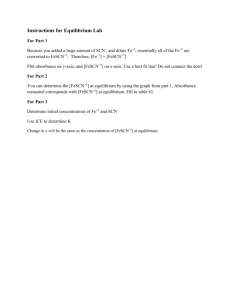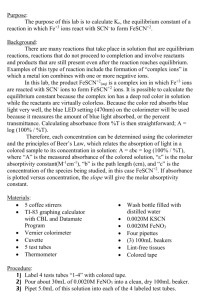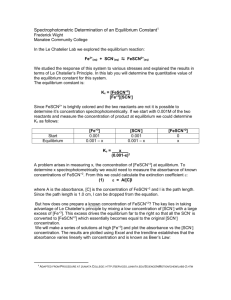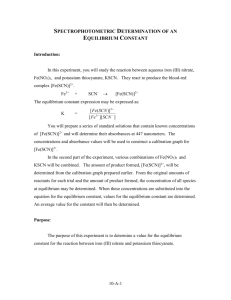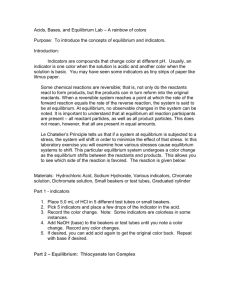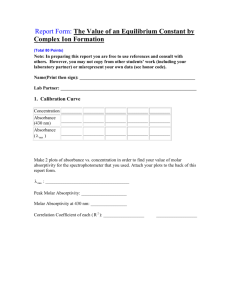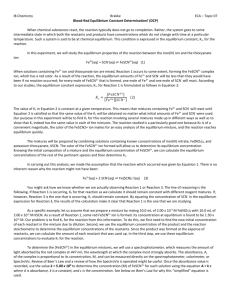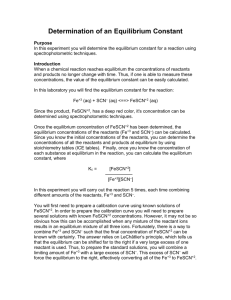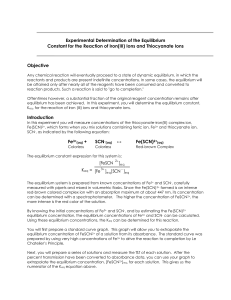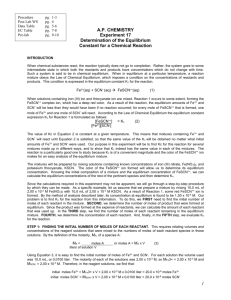Spectrophotometric Determination
advertisement
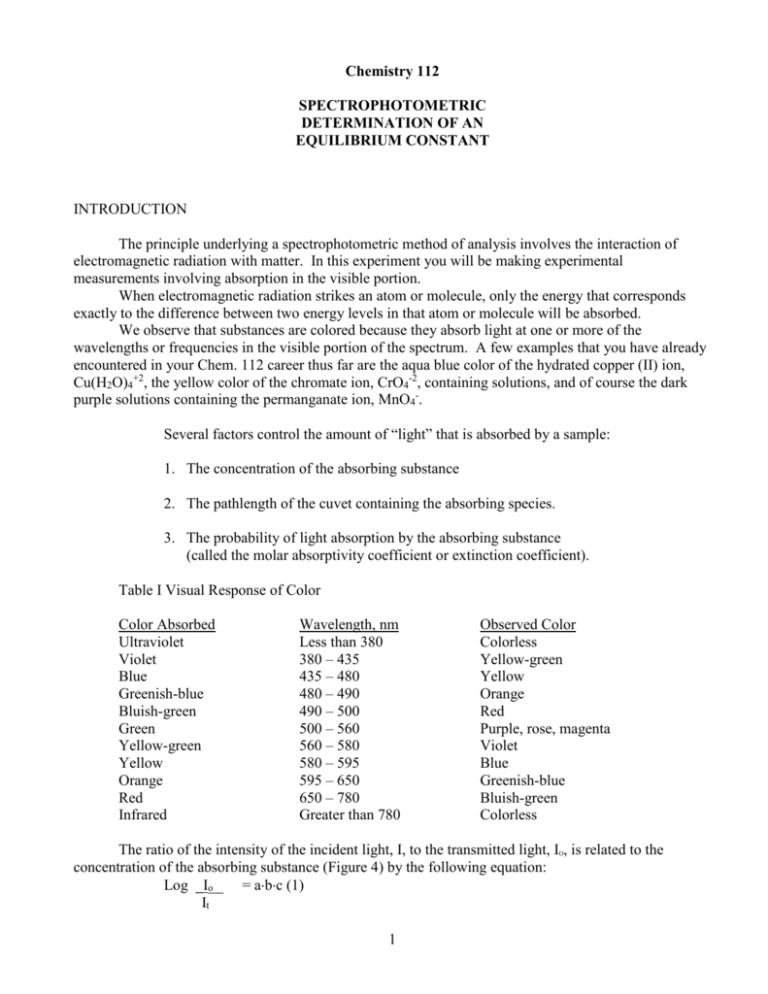
Chemistry 112 SPECTROPHOTOMETRIC DETERMINATION OF AN EQUILIBRIUM CONSTANT INTRODUCTION The principle underlying a spectrophotometric method of analysis involves the interaction of electromagnetic radiation with matter. In this experiment you will be making experimental measurements involving absorption in the visible portion. When electromagnetic radiation strikes an atom or molecule, only the energy that corresponds exactly to the difference between two energy levels in that atom or molecule will be absorbed. We observe that substances are colored because they absorb light at one or more of the wavelengths or frequencies in the visible portion of the spectrum. A few examples that you have already encountered in your Chem. 112 career thus far are the aqua blue color of the hydrated copper (II) ion, Cu(H2O)4+2, the yellow color of the chromate ion, CrO4-2, containing solutions, and of course the dark purple solutions containing the permanganate ion, MnO4-. Several factors control the amount of “light” that is absorbed by a sample: 1. The concentration of the absorbing substance 2. The pathlength of the cuvet containing the absorbing species. 3. The probability of light absorption by the absorbing substance (called the molar absorptivity coefficient or extinction coefficient). Table I Visual Response of Color Color Absorbed Ultraviolet Violet Blue Greenish-blue Bluish-green Green Yellow-green Yellow Orange Red Infrared Wavelength, nm Less than 380 380 – 435 435 – 480 480 – 490 490 – 500 500 – 560 560 – 580 580 – 595 595 – 650 650 – 780 Greater than 780 Observed Color Colorless Yellow-green Yellow Orange Red Purple, rose, magenta Violet Blue Greenish-blue Bluish-green Colorless The ratio of the intensity of the incident light, I, to the transmitted light, IO, is related to the concentration of the absorbing substance (Figure 4) by the following equation: Log _Io__ = abc (1) It 1 where “a” is called the molar absorptivity coefficient, “b” is the thickness of the absorbing substance in centimeters, and “c” is the concentration of the absorbing substance expressed in moles per liter. The quantity log Io is generally referred to as the aborbance, A. Equation (1) then becomes: It A=abc Eqn. 2 The equation is commonly referred to as Beer’s law. From Equation (2) the absorbance, “A,” is directly proportional to the molar concentration, “c,” of the absorbing substance, provided that the same spectrophotometric cell is used for all measurements and that wavelength of the light is the same. The magnitude of the equilibrium constant, Kc, expresses the position of equilibrium for a chemical system. For example, a large equilibrium constant indicates the position of the equilibrium to be far to the right and a small value indicates the position of the equilibrium to be far to the left. At a given temperature the value of K is constant for a given chemical system. In this experiment you will be determining Kc for the equilibrium system represented by the following equation: Fe(H2O)6+3 + SCN- FeSCN(H2O)5+2 + H2O In a dilute aqueous solution the concentration H2O is essentially constant. As a result, the water of hydration can be neglected and the equation becomes Fe+3 + SCN- ⇌ FeSCN+2 for which the equilibrium expression is [FeSCN+2] Kf = [Fe+3][SCN-] The equilibrium system will be prepared by mixing known concentrations of Fe+3 and SCN-. In that the FeSCN+2 complex is a deep blood-red color with an absorption maximum at about 447 nm, its concentration can be determined spectrophotometrically. By knowing the initial concentrations of Fe+3 and SCN- and by measuring the FeSCN+2 equilibrium concentration spectrophotometrically, the equilibrium concentrations of Fe+3 and SCN- can be determined and Kc for the system can be calculated. First you will prepare a set of standard solutions containing known concentrations of the FeSCN+2 complex. The absorbance of each will be plotted versus the FeSCN+2 molar concentration to establish a calibration curve from which the concentration of FeSCN+2 can be determined for the remaining systems. In the preparation of the standards, the Fe+3 concentration will be in large excess compared to the SCNconcentration. The assumption is made that the FeSCN+2 concentration approximates the original SCNconcentration; i.e. it is assumed that the position of equilibrium is driven so far to the right that for all practical purposes, all of the SCN- is complexed by the large excess of Fe+3 to form FeSCN+2. SAFETY: KSCN and HNO3: Dilute Nitric acid and KSCN can harm eyes, skin, and clothing. Handle with care. Any spilled on the skin or splashed into your eyes must be rinsed with a large volume of water. DISPOSAL: Dispose of mixture in the sink with running water. 2 EXPERIMENTAL PROCEDURE Each pair of students is to check out a SPECT KIT, 25 ml pipet and pi pump from the stockroom. The glassware in the “SPEC” kit is already clean and does not need to be re-cleaned. A. The Set of Standards Solutions Pipet 2, 3, 5, 10, 15 ml. of 0.00200 M KSCN and 25.00 ml of .200 M Fe(NO3)3 solution into separate 100 ml volumetric flasks and dilute to the 100ml mark with 0.1 M HNO3. Pipet no KSCN but 25.00 ml of .200M Fe (NO3)3 into another 100 ml volumetric flask and dilute to the 100ml mark with 0.1 M HNO3 – this will be your blank. These solutions are to be used to establish a calibration curve for determining the equilibrium FeSCN+2 concentration spectrophotometrically. Composition of Test Solutions for Calibration Curve- (include this table!) Solution Blank 1 2 3 4 5 0.200 M Fe(NO3)3 [in 0.1 M HNO3)3] 25.00 ml 25.00 ml 25.00 ml 25.00 ml 25.00 ml 25.00 ml 0.00200 M KSCN 0.00 ml 2 ml 3 ml 5.00 ml 10.00 ml 15.00 ml 0.1 M HNO3 dilute to: 100 ml 100 ml 100 ml 100 ml 100 ml 100 ml Your instructor will go over the use and operation of the spectrophotometer. A summary of the procedure to be followed is as follows: 1. Turn on the instrument allow to warm up for at least 15 minutes. 2. Set the instrument to read Absorbance by pushing the Trans/Abs button. 3. Set the wavelength to 447 nm. 4. Insert the blank which is 0.1 M NHO3 and zero the instrument. 5. Insert the Unknown or Standard solution. 6. Read Absorbance, A. Fill the cuvet halfway with your solution, and then wipe the outside with a clean Kim-wipe to remove water and fingerprints. Touch only the top of the cuvet thereafter. Any foreign substance on the outside of the cuvet will affect the intensity of the transmitted light. Record the Absorbance of each solution at 447 nm. Plot A versus [FeSCN+2]. Draw the best straight line through the five points and the origin. 3 B. The Set of Equilibrium Solutions Prepare the following set of solutions in 7-inch test tubes for the determination of the [FeSCN+2] in the equilibrium systems. Use pipets for the volumetric measurements. Stir each solution thoroughly with a clean and DRY stirring rod. Fill and then wipe the cuvet with a Kim-wipe as was done before. Composition of Test Solutions for Determination of Kc (include this table) Solution Blank 1 2 3 4 0.00200 M Fe(NO3)3 (in 0.1 M HNO3) 5.00 ml 5.00 ml 5.00 ml 5.00 ml 5.00 ml 0.00200 M KSCN 0 ml 2.00 ml 3.00 ml 4.00 ml 5.00 ml 0.1 M HNO3 5.00 ml 3.00 ml 2.00 ml 1.00 ml -------- Record the Absorbance for each solution. Determine the FeSCN+2 equilibrium concentration for each solution. Be careful in handling the cuvets. 4 Name_________________________ (Last) (First) SPECTROPHOTOMETRIC DETERMINATION OF AN EQUILIBRIUM CONSTANT PURPOSE (1/4page): EQUATIONS (2 equations, only!): MATERIALS: SAFETY: DISPOSAL: PROCEDURE: DATA: A. Set of Standards Solutions 1. Molar concentration Fe(NO3)3 2. Molar concentration KSCN __________ __________ (Show the setups for each of the required calculations in the table below for Standard Solutions at the bottom of this page.) 3. Table: Standard Solutions Volume KSCN (ml) Moles FeSCN2+ [FeSCN+2] Absorbance, A 1 2 3 4 5 4. Sample Setups Molarity of SCN-, [SCN-] in 100 mL KSCN B. GRAPH (requires a full page-leave a full page blank!) Graph should be taped into the lab book page. The entire edge should be taped down onto the page. 5 C. Set of Equilibrium Solutions 1. Molar concentration Fe(NO3)3 2. Molar concentration KSCN __________ __________ 3. Table: Solutions a. Volume Fe(NO3)3 (ml) b. Moles Fe3+, initial c. Volume KSCN (ml) d. Moles SCN-, initial e. Absorbance 1 2 3 4 . CALCULATIONS: Show a sample calculation for each of the required calculations. Solutions 1. [FeSCN2+], from calibration curve 2. [Fe3+] a. Moles FeSCN2+ in solution at equilibrium b. Mole Fe3+ complexed c. Mole Fe3+ uncomplexed d. [Fe3+] at equilibrium, uncomplexed (mole/liter) 3. [SCN-] a. Moles SCN- complexed b. Moles SCN- uncomplexed c. [SCN-] at equilibrium, uncomplexed 4. ___[FeSCN2+]___ Kf = [Fe3+][SCN-] 5. Average Kf 6. Standard Deviation __________ __________ 6 1 2 3 4 Sample Calculations setups (1-1/2 pages) 3b. Moles Fe3+, initial From data table C.3 d. Moles SCN-, initial 2. [Fe3+] a. Moles FeSCN2+ in solution at equilibrium b. Moles Fe3+ complexed c. Moles Fe3+ uncomplexed d. [Fe3+] at equilibrium, uncomplexed (mole/liter) 3. [SCN-] b. Moles SCN- complexed c. Moles SCN- uncomplexed d. [SCN-] at equilibrium, uncomplexed (mole/liter) 4. Kf 5. Average Kf 6. Standard deviation QUESTIONS (1/4 page): 1. What effect would the use of a cuvet that has fingerprints and/or waterspots on it have on the absorbance reading for a FeSCN+2 solution? 3. What effect would the error in question 1 have on the experimental value for the equilibrium constant? SUMMARY (1-1/2 pages): 7
